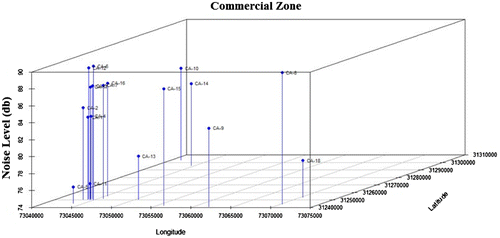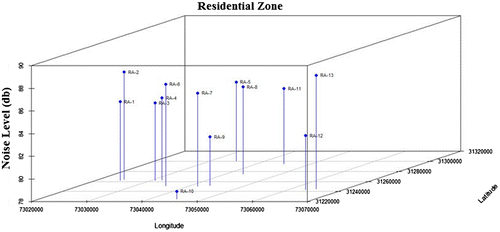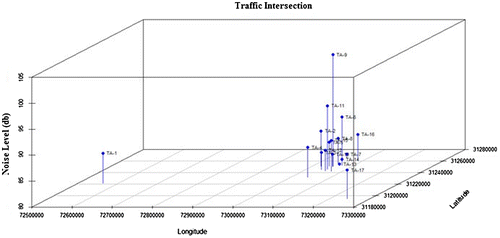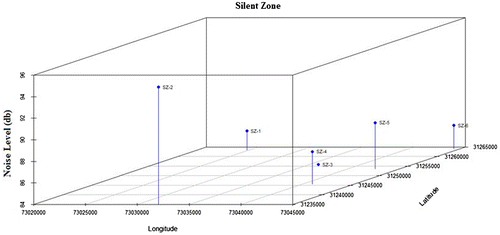Abstract
Noise is surely one of the most undesirable by-products of the modern mechanized lifestyle. We see the rush and the fights between the masses relating to the traffic laws everywhere, their violations and their after-shocks. To assess the noise levels in busy roads of Faisalabad, a study was conducted at three different times of a day i.e. morning (9:00 am), noon (3:00 pm) and evening (6:00 pm). Out of a total of 85 sites, 6 sites at morning time, 52 sites at noon time and 27 sites at evening time were exceeding the permissible limit set by Pak-EPA (NEQS). The maximum noise levels recorded were 101.7 dB (A) at State Bank Road, 107.9 dB(A) at Jhal Pull and 107.9 dB(A) at Ayub Agricultural Research Institute (AARI) at morning, noon and evening, respectively. At the same time, the minimum noise levels recorded were 68.3(A) dB at Jhang Bazar, 75.7 dB(A) at Nishat Abad Pull and 71.3 dB (A) was at Jamia Chistian Chowk in morning, noon and evening, respectively. Overall maximum noise level of 107.9 dB(A) was found at two sites, and the minimum noise level was 68.3 dB(A).
Introduction
Noise is any undesirable sound which creates a disturbance. It comprises all the sounds in our communities that create nuisance and disturbance in the specific environment. Noise is a constant threat to human health (Nawaz & Hasnain, Citation2013), and it will continuously grow because of continuous development of infrastructure and transportation evolution in the roads and air traffic (Allen et al., Citation2009; Ausejo, Recuero, Asensio, Pavon, & Lopez, Citation2010; Brainard, Jones, Bateman, & Lovett, Citation2004; Ehrampoush, Halvani, Barkhordari, & Zare, Citation2012; Fang & Ling, Citation2003; Geurs & Wee, Citation2006; Li & Tao, Citation2004; Li, Tao, & Dawson, Citation2002; Ross et al., Citation2011). The potential health effects include impairment of health, hypertension, cardiovascular disease and raised blood pressure which effect on residential, social, working and learning behaviour. It reduces sleeping, working concentration, communication and recreation attitude (Goines & Hagler, Citation2007; Stansfeld & Matheson, Citation2003).
Traffic noise is the most important source of environmental annoyance (Cerda, Lacatis, & Gimenez, Citation2013; Fang & Ling, Citation2005; Ising & Kruppa, Citation2004; Weber, Citation2012). Humans are the main responsible for changing world’s acoustic background with its own produced sounds with different pitch and amplitudes. These sounds are hazardous for organisms particularly birds. Noise reduces nesting species density/population richness in different avian communities due to the alternation of predator–prey interactions (Calixto, Diniz, & Zannin, Citation2003; Francis, Ortega, & Cruz, Citation2009; Golmohammadi, Abbaspour, Nassiri, & Mahjub, Citation2009; Hosseini, Parsakhoo, & Seifi, Citation2012; Khan & Ali, Citation2014; Martins, Godinho, & Picado-Santos, Citation2013; Oyedepo, Abdullahi, & Abdullahi, Citation2010; Sharma, Bodhe, & Schimak, Citation2014). As far as the effects on humans are concerned, the studies in the city of Curitiba, Brazil also showed that 93.3% locations displayed over 65 dB noise and 40.3% locations measured display over 75 dB noise level (Zannin, Diniz, & Barbosa, Citation2002).
Noise in hospitals and schools is also a serious problem. Noise levels are also above the permissible limits prescribed by the WHO. A study in Chandigarh, India, up to 80 dB noise level was measured at the emergency and around. About 74% of the total hospital patients said that they have irritation due to loud noise, 40% reported a headache, 29% reported a loss of sleep and 8% reported hypertension (Allen & Adar, Citation2011; Atkinson, Citation1905; Belojevic & Saric-Tanaskovic, Citation2002; Khaiwal et al., Citation2016; Peterson, Augenstein, Tanis, & Augenstein, Citation1981; Quis, Citation1999). The same was also found in Karachi, Pakistan, that noise levels were higher during mornings and evenings because of the school and offices timings. Maximum noise level was found over 101 dB, which is close to 110 dB which cause hearing impairment (Zafar, Anjum, Anjum, Iftikhar, & Manzar, Citation2015).
Faisalabad is the Manchester of Pakistan, and it is called so because of the textile industry. Its population is also increasing due to employment and better living standards. Besides this, Faisalabad is also facing some serious threats like air and noise pollution due to heavy traffic. The noise level of different cities of Pakistan is shown in Table .
Table 1. Noise levels in different cities of Pakistan.
Keeping in view the above-mentioned facts, a study was planned to check the status of noise levels on different roads of Faisalabad, and the values were compared with National Environmental Quality Standards (NEQS).
Material and methods
This study area Faisalabad stands in the rolling flat plains of north-east Punjab, between longitude 73°74 east and latitude 30°31.5 north. In this study, 85 sites were selected for noise level measurements during rush hours of the morning, noon and evening during summer 2016. Noise levels were measured from five categories of zones, i.e., residential, commercial, industrial, traffic junctions and silent zones as per Pak-EPA and CPCB drafts zones during rush hours of the morning, noon and evening times. A digital Sound Level Meter model 40477 made by the Ex-tech of type 2 with a frequency range of 31.5 Hz–8000 Hz was used which can measure noise level between 0 and 150 dB and calibrated at 100 dB (A). All readings were taken at 1.5 m height from the ground (Ghafoor et al., Citation2012) and 7.5 m away from the source (Pak-EPA). From each site, five readings were taken, and their means were used. For the assessment of results, following sound parameters were used,
| • | LAeq = A-weighted sound equivalent sound level. | ||||
| • | Lmax and Lmin at morning, noon and evening time. | ||||
| • | Tf = Traffic frequency. | ||||
| • | Lm, Ln and Le = Average sound level at morning, noon and evening. | ||||
Table 2. Noise risk zone criteria used for the present study.
Results and discussion
Sampling locations were divided into sub-categories described by Pak-EPA, i.e., industrial area, commercial area, silent zone, residential area and traffic intersections. The analysis was done based on rush hours at temporal basis (morning, noon and evening times).
Industrial zones
These areas were selected according to the vicinity of the roads to the industries/industrial areas. The noise levels were varied from 76.8 to 85.7 dB during the morning, 75.7 to 97.3 dB at noon and 74.9 to 98.6 dB at evening time. The different noise levels of the industrial zone have shown in Table . Maximum noise level recorded was 98.6 dB at Adah Bawa Chak in the evening as this area has many small and large scale industries while the minimum level was recorded 74.9 dB at Faisalabad-Jhang Road in the evening time. The average noise level in dB of the industrial zones is shown in Figure along with their location.
Table 3. Three Times Noise Index Values in the categorized areas.
Commercial zones
As Faisalabad is an urban area, commercial places are spread all over the city. These can be isolated shops at the roadside or markets/supermarkets in colonies, bazaars, etc. The commercial areas are present almost every side of the roads, and mostly sellers also occupy the footpaths. The noise levels in these areas varied from 68.3 to 95.3 dB. The noise levels were varied from 68.3 to 85.3 dB during the morning, 77.3 to 98.9 dB and 75.0 to 95.3 dB at noon and evening time, respectively. Although some sites showed low levels of noise but mostly showed noise levels which were over the limits of NEQS. Table shows the noise index of different commercial areas.
Table 4. Three Times Noise Index Values in the categorized area.
The minimum noise level was at morning time which was 68.3 dB at the site of Jhang Bazar, Rajbah Road and Mintgomri bazar while maximum noise level of 95.3 dB was observed at Rail Bazar Gumti Chowk on evening time because area is situated by government offices like District Coordination Officer’s office, District Council, TMA office, Irrigation Department Offices and Environment Protection Office. All the employees of these offices use this square to move to their homes and offices in the evening. Figure shows the average noise level of the commercial area.
Residential area
People try to build their homes in peaceful areas but when population increases, the need for houses increases and people tend to make their homes in open places. In these study areas, the noise levels were between 71.3 and 95.7 dB. The Table shows that noise level at morning was 75.0 to 85.3 dB, 84.7 to 94.7 dB at noon and 71.3 to 95.7 dB at evening time. The maximum noise at morning time was 85.3 dB at Jinnah Colony due to the movement of school children/college/university going student’s vans, bikes, rickshaws, etc. At noontime was 94.7 dB at Jattianwala Road, Ghulam Muhammad Abad and at evening time was 95.7 dB in Azam Square and Ghulam Muhammad Abad. Minimum noise at morning time was 75.0 dB at Flats, Susan Road due to the large distance from road and presence of a park in front of flats and corner location from city, noontime was 84.7 dB at Azam Chowk, Ghulam Muhammad Abad and at evening time was 95.7 dB at same place due to the shops/small markets and schools in the residential areas. The average noise level of residential areas is shown in Figure , according to location.
Table 5. Three Times Noise Index Values in the categorized areas.
Traffic intersections
Due to a large population, there is much traffic and heavy infrastructure of roads to facilitate people as well as industries. The noise levels were between 75.4 and 101.7 dB at morning, 82.7–107.2 dB at noon and 69.9–99.5 dB at evening time. Maximum noise at morning time was 101.7 dB at State Bank Road due to the government offices present in that area, noontime was 107.2 dB at the same place and at evening time was 99.5 dB at Jhall Pull. Table shows the minimum noise at morning time that was about 75.4 dB at Susan Road, noontime was 82.7 dB at Chiniot-Sargodha Road, Sadhar Bye-Pass and at evening time was 69.9 dB at Chenab Square due to heavy traffic allowed at evening time only in the city. Figure shows the average noise level at different road intersections of the city.
Table 6. Three Times Noise Index Values in the categorized areas.
Silent zones
In sensitive zones, we considered mostly education institutes like the University of Agriculture Faisalabad, Government College, University and Hospitals. The noise levels were between 71.3 and 107.9 dB. The ranges were 71.3–83.6 dB at morning, 83.6–98.9 dB at noon and 77.3–107.9 dB at evening time as shown in Table . The maximum noise at morning time was 83.6 dB at Ayub Agricultural Research Institute (AARI), noontime was 98.9 dB at near old board of intermediate and secondary education (BISE) office (Now Kissan Hall, UAF) and at evening time was 107.9 dB at AARI due to vans/rickshaws and bikes of students as this area has many colonies in it and large number of students move through this area. Minimum noise at morning time was 71.3 dB at Zero Point, University of Agriculture, Faisalabad, noontime was 83.6 at the same place and at evening time was 77.3 dB at BISE. The average noise level of silent zones of the main points is shown in Figure . The classification of study area according to noise range briefly described in Table . The results show that noise levels in many areas of the city exceeded the limit of 85 dB (A) as recommended by WHO and NEQS. The exceeding limits cause annoyance and interrupt sleep and cognitive power.
Table 7. Three Times Noise Index Values in the categorized areas.
Table 8. Noise range classification of present study.
Conclusion
Noise assessment presented in this study has revealed that even in an industrial city such as Faisalabad, noise levels are higher than the limits set up by Pak-EPA in terms of NEQS. The study shows that most of the areas of city have subjected to unacceptable noise, and the noise level was high as 70–95 dB which is too high than the limits. High noise levels in well-developed and organized areas like residential apartments, shopping areas are a major concern. This is due to more use of the roads alongside it by all types of public, commercial, loader trucks and private transport vehicles. It is a fact that immediate mitigation measures are required to control the high road traffic noise emissions. Mitigation measures include maintenance of automobiles, regular servicing, and tuning of vehicles, fixing of silencers, installation of controlling barriers between noise source and receiver. Other measures include raising the awareness among the local community and strict enforcement of laws.
Disclosure statement
No potential conflict of interest was reported by the authors.
References
- Allen, R.W., & Adar, S.D. (2011). Are both air pollution and noise driving adverse cardiovascular health effects from motor vehicles? Environmental Research, 111, 184.10.1016/j.envres.2010.11.004
- Allen, R. W., Davies, H., Cohen, M.A., Mallach, G., Kaufman, J.D., & Adar, S.D. (2009). The spatial relationship between traffic-generated air pollution and noise in 2 US cities. Environmental Research, 109, 334.10.1016/j.envres.2008.12.006
- Atkinson, R. (1905). Ecology of sound: The sonic order of urban space. Urban Studies, 44(10), 2007.
- Ausejo, M., Recuero, M., Asensio, C., Pavon, I., & Lopez, J.M. (2010). Study of precision, deviations and uncertainty in the design of the strategic noise map of the macrocenter of the city of Buenos Aires, Argentina. Environmental Modeling & Assessment, 15, 125.10.1007/s10666-009-9191-9
- Banerjee, D., Chakraborty, S.K., Bhattacharyya, S., & Gangopadhyay, A. (2008). Evaluation and analysis of road traffic noise in Asansol: An industrial town of Eastern India. International Journal of Environmental Research and Public Health, 5(3), 165–171.10.3390/ijerph5030165
- Belojevic, G., & Saric-Tanaskovic, M. (2002). Prevalence of arterial hypertension and myocardial infarction in relation to subjective ratings of traffic noise exposure. Noise Health, 4(16), 33.
- Brainard, J.S., Jones, A.P., Bateman, I.J., & Lovett, A.A. (2004). Exposure to environmental urban noise pollution in Birmingham, UK. Urban Studies, 41(13), 2581.10.1080/0042098042000294574
- Calixto, A., Diniz, F.B., & Zannin, P.H.T. (2003). The statistical modeling of road traffic noise in an urban setting. Cities, 20(1), 23.10.1016/S0264-2751(02)00093-8
- Cerda, S., Lacatis, R., & Gimenez, A. (2013). On absorption and scattering coefficient effects in modellisation software. Acoustics Australia, 41(2), 151.
- Ehrampoush, M.H., Halvani, G.H., Barkhordari, A., & Zare, M. (2012). Noise pollution in urban environments: A study in Yazd city, Iran. Polish Journal of Environmental Studies, 21(4), 1095.
- Fang, C.-F., & Ling, D.-L. (2003). Investigation of the noise reduction provided by tree belts. Landscape Urban Plan, 63, 187.10.1016/S0169-2046(02)00190-1
- Fang, C.-F., & Ling, D.-L. (2005). Guidance for noise reduction provided by tree belts. Landscape Urban Plan, 71, 29.10.1016/j.landurbplan.2004.01.005
- Francis, C.D., Ortega, C.P., & Cruz, A. (2009). Noise pollution changes avian communities and species interactions. Current Biology, 19, 1415–1419.10.1016/j.cub.2009.06.052
- Geurs, K.T., & Wee, B.V. (2006). Ex-post evaluation of thirty years of compact urban development in the Netherlands. Urban Studies, 43(1), 139.10.1080/00420980500409318
- Ghafoor, A., Murtaza, G., Sabir, M., Hamaad, H.R., Saifullah, M., & Rahman, Z.U. (2012). Chapter 9. Environment pollution- types, sources, and management. Institute of soil and environmental science. Faisalabad: University of Agriculture. pp-229.
- Goines, L., & Hagler, L. (2007). Noise pollution: A modern plague. Southern Medical Journal-Birmingham Alabama, 100, 287.10.1097/SMJ.0b013e3180318be5
- Golmohammadi, R., Abbaspour, M., Nassiri, P., & Mahjub, H. (2009). A compact model for predicting road traffic noise. Iran. Journal of Environmental Health Science and Engineering, 6(3), 181.
- Hosseini, S.A., Parsakhoo, A., & Seifi, R. (2012). Investigating the effects of technical parameters of forest road planning and building on traffic noise reduction. Polish Journal of Environmental Studies, 21(5), 1217.
- Ising, H., & Kruppa, B. (2004). Health effects caused by noise: Evidence in the literature from the past 25 years. Noise and Health, 6, 5–13.
- Khaiwal, R., Singh, T., Tripathy, J.P., Mor, S., Munjal, S., Patro, B., & Panda, N. (2016). Assessment of noise pollution in and around a sensitive zone in North India and its non-auditory impacts. Science of the Total Environment, 566–567, 981–987.10.1016/j.scitotenv.2016.05.070
- Khan, H.U., & Ali, S.I. (2014). Evaluation of road traffic noise pollution in Quetta (Pakistan). American Journal of Modern Physics, 3(2), 29.10.11648/j.ajmp.20140302.11
- Li, B., & Tao, S. (2004). Influence of expanding ring roads on traffic noise in Beijing City. Applied Acoustics, 65, 243.10.1016/j.apacoust.2003.09.005
- Li, B., Tao, S., & Dawson, R.W. (2002). Evaluation and analysis of traffic noise from the main urban roads in Beijing. Applied Acoustics, 63, 1137.10.1016/S0003-682X(02)00024-5
- Martins, M., Godinho, L., & Picado-Santos, L. (2013). Numerical evaluation of sound attenuation provided by periodic structures. Archives of Acoustics, 38(4), 503.
- Nawaz, S.K., & Hasnain, S. (2013). Occupational noise exposure may induce oxidative DNA damage. Polish Journal of Environmental Studies, 22(5), 1547.
- Oyedepo, S., Abdullahi, O., & Abdullahi, S.A. (2010). Comparative analysis of noise descriptors in some selected areas in Ilorin Metropolis, Nigeria. Noise Control Engineering Journal, 58(6), 646.
- Peterson, E.A., Augenstein, J.S., Tanis, D.C., & Augenstein, D.G. (1981). Noise raises blood pressure without impairing auditory sensitivity. Science, 211(4489), 1450.10.1126/science.7466404
- Quis, D. (1999). Exposure to nocturnal road traffic noise: Sleep disturbance and its after effects. Noise Health, 1(4), 11.
- Ross, Z., Kheirbek, I., Clougherty, J.E., Ito, K., Matte, T., Markowitz, S., & Eisl, H. (2011). Noise, air pollutants and traffic: Continuous measurement and correlation at a high-traffic location in New York City. Environmental Research, 111, 1054.10.1016/j.envres.2011.09.004
- Sharma, A., Bodhe, G.L., & Schimak, G. (2014). Development of a traffic noise prediction model for an urban environment. Noise & Health, 16 (68), 63.10.4103/1463-1741.127858
- Stansfeld, S.A., & Matheson, M.P. (2003). Noise pollution: Non-auditory effects on health. British Medical Bulletin, 68, 243–257.10.1093/bmb/ldg033
- Weber, M. (2012, August 19–22). Quiet urban areas: Repositioning local noise policy approaches – Questioning visitors on soundscape and environmental quality. Internoise 2012, New York City, USA.
- Zafar, I.Z., Anjum, G.A., Anjum, N., Iftikhar, N., & Manzar, S. (2015). An environmental evaluation of school transport in Islamabad: A case study of sector H-8. Pakistan Journal of Engineering and Applied Sciences, 16, 1–16.
- Zannin, P.H.T., Diniz, F.B., & Barbosa, W.A. (2002). Environmental noise pollution in the city of Curitiba, Brazil. Applied Acoustics, 63, 351–358.10.1016/S0003-682X(01)00052-4





